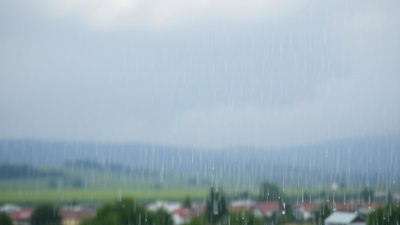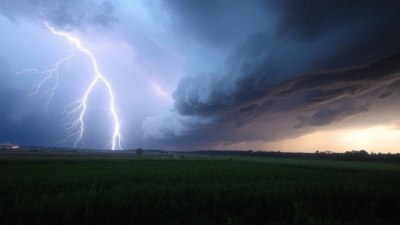The Psychological Reason We Blame the Weather for Our Problems (Even If It’s Nice)
Explore the psychological reasons behind blaming weather for life's challenges, even in pleasant conditions. Understand the mindset.

Image by cookie-studio on Freepik
The weather is a constant influence in our lives. From our daily routines to our moods, the state of the atmosphere can play a significant role in how we perceive ourselves and our problems. It's common for individuals to attribute their difficulties to the weather, whether it be gloominess on a rainy day or an unexpected heatwave. We often find ourselves saying things like, 'I’m feeling down because it’s overcast' or 'I just can’t concentrate when it’s too hot.' But why do we have this tendency to blame the weather for our problems, even when conditions are seemingly pleasant? To understand this behavior, we need to delve into the complexities of human psychology and our relationship with nature.
The Psychological Link Between Weather and Mood
Research has long suggested a clear relationship between weather conditions and individual mood. The concept of Seasonal Affective Disorder (SAD) is a textbook example of this, where shorter days and lack of sunlight in winter months bring about feelings of depression in some individuals. But even outside of clinical conditions, many people report feeling more energized and optimistic on sunny days, while gray and rainy weather can lead to feelings of lethargy or sadness. The connection is partly biological, as sunlight affects serotonin levels in the brain, which in turn influences mood. However, the link between weather and mood is not just a one-way street; our perceptions of the weather can also color our experiences.
The Role of Attribution Theory
Attribution theory provides a framework for understanding how we interpret causes for our behaviors and feelings. When faced with challenges, individuals often look for external sources to blame, especially if those sources are easily recognizable. Weather serves as a universal and tangible scapegoat. On a gloomy day, we might feel less motivated to take on challenges, attributing our lack of productivity to the dreary weather instead of recognizing other factors, such as our own mindset or external pressures. This external attribution helps individuals maintain their self-esteem by avoiding personal accountability. It’s easier, after all, to say the weather is bad than to confront any deeper issues that might be at play.
The Comfort of Shared Experiences
Blaming the weather has a social component. When people encounter difficulties, bringing up the weather can foster connection and rapport among peers. Comments like, 'Who can be productive in this heat?' serve as an icebreaker, creating camaraderie around a shared experience. This social aspect allows individuals to express feelings of frustration or discomfort without necessarily confronting the underlying issues. When multiple people agree that the weather is to blame, it creates a communal narrative that reinforces the belief. This psychological defense mechanism not only normalizes the experience of discomfort but also alleviates feelings of isolation that might arise from personal challenges.
The Influence of Cognitive Bias
Cognitive biases also play a crucial role in our tendency to blame external conditions like the weather. One such bias is confirmation bias, where individuals naturally seek information that confirms existing beliefs while dismissing contrary evidence. If someone believes the weather significantly impacts their mood, they may highlight instances when they felt bad due to weather conditions while ignoring days where they felt great despite the rain. This selective thinking reinforces the belief that weather is a primary cause of their problems. Another bias is the negativity bias, where negative experiences or feelings draw more attention and weight than positive ones. Thus, when we feel down, we are more likely to attribute that feeling to the weather as opposed to acknowledging positive experiences that may also be present.
The Impact of Cultural Narratives
The way different cultures interpret weather can also affect individual perspectives. In some cultures, a sunny disposition is valued, and cloudy or rainy days might represent a collective feeling of despair or lethargy. Additionally, various idiomatic expressions and narratives tying weather to emotional states are deeply entrenched in language and literature. Expressions such as 'a dark cloud hanging over me' can conjure a sense of foreboding, while 'sunshine and happiness' suggests a direct correlation between the sun and positive emotions. These cultural narratives shape our very understanding of weather and its effects on our mental states. If the cultural narrative always links bad feelings to bad weather, individuals are more likely to adopt this perspective and blame weather for personal setbacks.
Navigating Personal Responsibility
Understanding the psychological reasons behind our inclination to blame the weather can unearth essential truths about personal responsibility. While it’s natural to look for external factors that influence our lives, recognizing the tendency to scapegoat weather can be a powerful step in fostering personal growth. Self-awareness is the first step towards addressing the underlying issues. Instead of resigning to statements like 'It’s too cold to go for a run,' we may ask ourselves whether a lack of motivation is the primary reason or if there are emotional barriers holding us back. Engaging in reflective practices, such as journaling, can help individuals disentangle weather-related complaints from genuine emotional struggles.
Embracing the Weather as Part of Life
Instead of viewing weather as an adversary that derails our plans, we can reframe how we perceive it. Every season offers unique experiences, challenges, and opportunities for growth. For example, rather than feeling grumpy about a rainy day, one could embrace it as a chance to enjoy indoor activities like reading or cooking. Recognizing the value in each weather type can cultivate resilience and adaptability. Initiating conversations about how diverse weather experiences can lead to varied emotional responses may also assist in changing personal perceptions. The goal is to gain a balanced view of how weather plays a part in our lives without letting it define our experiences.
The Power of Mindfulness and Acceptance
Practicing mindfulness can be an effective approach to overcome the tendency to blame weather for personal woes. Mindfulness encourages individuals to develop a keen awareness of their thoughts and feelings without judgment. By acknowledging when we associate feelings of unease or sadness with certain weather conditions, we can consciously shift our mindset. For instance, during a rainy day, rather than focusing solely on the negative aspects, we may choose to find gratitude in the coziness of being indoors or the natural beauty that rain brings to the environment. Acceptance of all types of weather as transient phenomena can reduce the stress related to external conditions. By accepting the weather for what it is, we open ourselves up to a fuller experience of life.
We often find ourselves blaming the weather for our issues, even when conditions are not inherently negative. This tendency can be examined through various psychological lenses, such as attribution theory, cognitive biases, and cultural narratives. Understanding these influences can empower us to take ownership of our thoughts and experiences. Rather than allowing the weather to dictate our moods and thoughts, we can learn to embrace its diversity. Ultimately, recognizing our inclination to attribute our problems to the weather can be a pathway towards greater self-awareness and emotional resilience, shaping a healthier perspective on both our lives and the environment around us.











